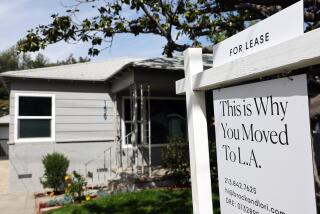New but the Same : Residence for Elderly Keeps Touches of Past
In 1951, Henrietta Oxe helped an older friend move into the Hollenbeck Home, the first licensed residence for the elderly in California. Oxe liked what she saw.
When she retired as a storage company manager in Beverly Hills in 1982, Oxe moved onto the eight-acre spread on South Boyle Avenue, across the street from Hollenbeck Park in Boyle Heights.
“I’d made up my mind a long time ago that that was how it was going to be,” Oxe, 72, said. “It isn’t any different really than having your own apartment.”
And since she first saw the home, founded in 1890, little has changed. “Basically it’s the same,” Oxe said.
One of the things that has not changed is what first attracted Oxe to the home: its financial stability, guaranteed by trusts set up by residents for their own care.
Recently another sort of stability was celebrated: seismic.
The home’s main building, a brick-and-stucco structure with one of the city’s first concrete foundations, was erected in 1895. It was razed in 1985 and rebuilt to comply with the city’s earthquake safety code. Although it has been in use since November, the new building was officially christened Wednesday.
The nonprofit home was founded in 1890 by Elizabeth Hollenbeck, widow of John Hollenbeck, a prominent figure in the early development of Los Angeles.
The new building was constructed in the Mission style of the preceding one, with broad arches fronting a veranda. But some changes were made. There are more straight lines and less ornamental carving. The halls are wider, and smoke alarms dot the ceiling every 70 feet. Offices and apartments take up most of the building.
But Hazel Riggs, one of the home’s 215 residents, misses the familiarity of the old building. “Like anything else, you have to get used to it,” she said.
Bits of the past remain, however. The original cornerstone is set in the new structure. And the parlor contains even older memorabilia, such as the white marble fireplace and the 105-year-old Steinway piano from the long-gone Victorian Hollenbeck house.
While the parlor and a bench beside the outdoor bird cages invite sedentary pursuits, residents say there is action aplenty.
“If anyone is bored, there’s something wrong with them,” said Ethel Riley, citing the painting and exercise classes among the organized activities she enjoys.
The social centerpiece of the home is the bazaar that takes place the first Tuesday of every month. The belongings of deceased residents that have been placed in trust and discards from others are sold. Several thousand dollars a month is usually raised. The money goes to such projects as a van used to ferry residents around and a contribution to the $6-million new building and landscaping.
When it opened, the home required a $300 trust from each prospective resident. Now the requirement is $40,000. That buys a private room and bath, meals, recreation and health care, including hospitalization, for the rest of the resident’s life and burial.
The average stay of 10 years has not changed in about 40 years, said William Heideman Sr., who was executive director from 1941 to 1986, but the age of the residents has. In the 1940s, most residents entered the home in their late 60s; now they are in their 80s.
More to Read
Sign up for Essential California
The most important California stories and recommendations in your inbox every morning.
You may occasionally receive promotional content from the Los Angeles Times.










